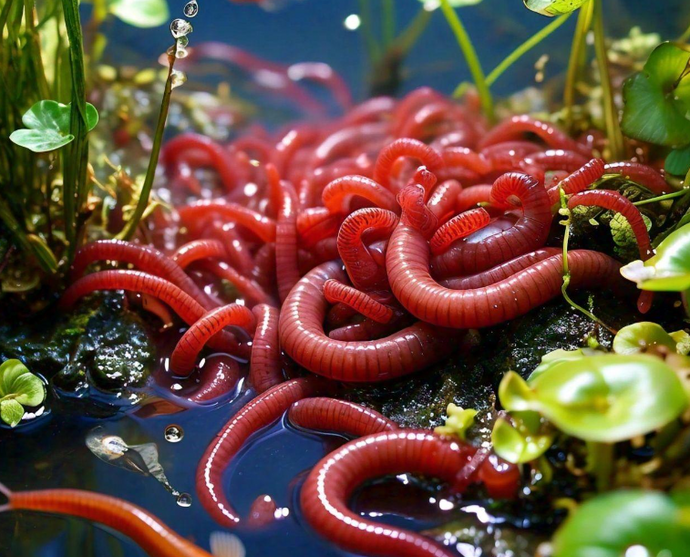The Role of Red Wigglers in Lasting Gardening
The combination of red wigglers into sustainable horticulture practices uses an engaging method to boosting soil health and minimizing organic waste. These microorganisms not just transform kitchen scraps into nutrient-dense garden compost via vermicomposting however additionally freshen the soil, advertising ideal problems for plant growth. As they break down facility organic products, they proactively foster a flourishing microbial environment essential for lasting agriculture. The implications of utilizing red wigglers expand past mere composting; their duty in shaping an extra sustainable future warrants a much deeper exploration of their benefits and useful applications.
Understanding Red Wigglers
Red wigglers, medically called Eisenia fetida, are a types of earthworm renowned for their duty in lasting horticulture and composting practices - red wigglers. These worms thrive in decomposing raw material, making them specifically effective in converting cooking area scraps and backyard waste into nutrient-rich garden compost. Unlike standard earthworms, red wigglers have a higher resistance for differing dampness degrees and can prosper in atmospheres with abundant natural material
The habitat preferences of red wigglers consist of moist, dark environments abundant in organic material, such as garden compost bins or worm farms. Their environmental duty extends beyond composting; they are essential in freshening the soil and assisting in vitamins and mineral cycling, which inevitably adds to much healthier garden environments. red wigglers. Understanding the biology and behavior of red wigglers is crucial for those seeking to execute reliable vermicomposting in sustainable gardening
Benefits of Vermicomposting
Vermicomposting deals various benefits that enhance sustainable gardening techniques and add to environmental health. One of the key advantages is the transformation of natural waste right into nutrient-rich compost, which boosts soil structure and fertility. The spreadings produced by red wigglers are loaded with useful microorganisms and crucial nutrients, making them an exceptional all-natural fertilizer.
Furthermore, vermicomposting substantially decreases garbage dump waste. By diverting kitchen area scraps and lawn waste from landfills, this practice not just decreases methane discharges-- a powerful greenhouse gas-- however also advertises a circular economy, where waste is repurposed as a resource.
Another advantage is the enhancement of dirt aeration and drainage (red wigglers). The burrowing activity of red wigglers develops channels in the dirt, permitting air and water to pass through even more conveniently, hence promoting a healthier origin system for plants
Moreover, vermicomposting can be done on a small range, making it accessible for metropolitan gardeners and those with minimal room. This approach motivates environmental stewardship and understanding, as people become a lot more involved with their waste management practices. Ultimately, vermicomposting stands for a lasting, efficient, and green method to gardening that profits both plants and the planet.
How to Begin Vermicomposting
Beginning your own vermicomposting system can be a gratifying venture that improves your lasting horticulture practices. To start, select an appropriate container, such as a plastic container or wooden box, with good drain and ventilation. The dimension will rely on the volume of kitchen scraps you produce; a bin of 10-14 gallons generally suffices for a home.
Following, prepare the bed linen product. Shredded newspaper, cardboard, and link coconut coir are outstanding alternatives, offering a comfortable environment for the red wigglers. Go for a bedding depth of about 4-6 inches, which need to be damp however not soggy.
When the bed linen is developed, introduce your worms. Red wigglers (Eisenia fetida) are the most appropriate for composting. Beginning with about one extra pound of worms for each 2-3 pounds of cooking area scraps weekly.
Begin adding cooking area waste, preventing meat, dairy products, and oily foods, as these can attract insects and produce smells. Consistently keep an eye on the container's moisture levels and temperature, ensuring it continues to be within the suitable range for worm task. With these preliminary actions, you'll be well on your means to producing nutrient-rich compost for your garden.
Maintaining a Healthy Worm Bin
A flourishing worm bin calls for regular treatment and attention to preserve an optimum environment for the red wigglers. Secret elements to monitor include moisture degrees, temperature level, and food supply. Keeping a wetness level similar to a wrung-out sponge is crucial; as well much water can bring about anaerobic problems, while insufficient can dry out the worms.
Temperature level is likewise vital, as red wigglers flourish in a series of 55 to 77 degrees Fahrenheit. Severe temperature levels can emphasize the worms, potentially causing mortality. For that reason, positioning the bin in a climate-controlled area or using protecting materials can help regulate temperature variations.

Finally, aeration is important. On a regular basis turning the bed linen and utilizing a fork or shovel can avoid compaction and promote air movement, ensuring a healthy and balanced, flourishing atmosphere for the red wigglers. By sticking to these techniques, garden enthusiasts can preserve a productive worm container that sustains sustainable gardening initiatives.
Effect On Dirt Health
Enhancing dirt health and wellness through the usage of red wigglers is a basic facet of sustainable gardening. By taking in natural issue, red wigglers damage down complicated materials right into simpler compounds, a process understood as vermicomposting.


Verdict
In conclusion, red wigglers considerably add to lasting gardening via their efficient vermicomposting methods. Their capability to convert organic waste into nutrient-rich garden compost enhances dirt fertility and sustains a varied microbial ecosystem. Moreover, their burrowing activity boosts soil oygenation and water retention, profiting plant health and wellness. By promoting waste reduction and promoting a round economic situation, red wigglers become necessary components in green gardening efforts, emphasizing their important function in ecological sustainability.
Comments on “Energetic red wigglers: Create rich compost”